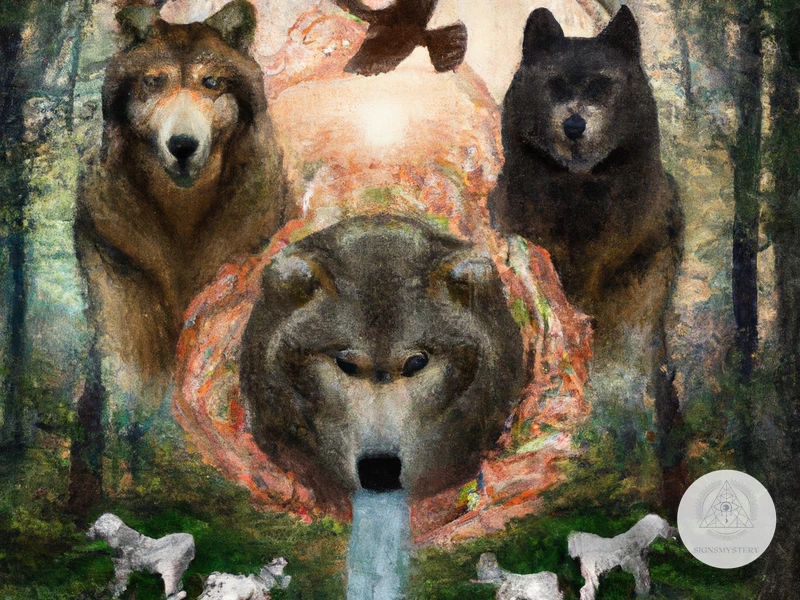Shamanism has been practiced by various cultures around the world for thousands of years and is based on the belief that there is a spiritual realm that can be accessed through altered states of consciousness. In Shamanism, there is a deep connection with nature, and one way this connection is expressed is through animal symbolism. Animals are seen as powerful spiritual beings with messages and guidance that can be accessed through shamanic practices. Understanding the significance of animal symbolism in Shamanism can lead to a deeper understanding and connection with the natural world.
What is Shamanism?
Shamanism is a practice that has been around for centuries and is still prevalent today in many parts of the world. It involves connecting with the spiritual world and using this connection to achieve healing, guidance, and personal growth. Central to the practice of shamanism is the belief in power animals, which are spirits that take the form of animals and offer their wisdom and guidance to the practitioner. These animals are not just symbols, but real entities that can be called upon for help. Understanding the role of power animals is essential for shamanic practice, as they are believed to provide a means of communication between the physical world and the spiritual realm. For more detailed information, you can visit the Power Animal Retrieval Guide, which explains types of power animals and their meanings, techniques for connecting with power animals, and how power animals can empower and transform one’s life.
What is Animal Symbolism?
Animal symbolism refers to the use of animals to represent certain ideas or concepts in various cultures, religions, and belief systems. Shamans use animal symbolism to understand the natural world and establish a deeper connection with it. Additionally, animal symbolism can be used to reflect, and potentially influence, human behavior and emotions.
In shamanism, each animal is believed to have its own unique spiritual and metaphysical characteristics, and these qualities are associated with specific types of energy or messages. For example, hawks and eagles are commonly regarded as symbols of vision and foresight, while snakes are seen as symbols of transformation and healing.
Animal symbolism is not limited to a single animal, as certain cultural groups or belief systems may have different interpretations of animal symbolism. In Native American culture, for instance, bears represent power, while in ancient Egypt, they were worshipped as gods. Understanding the animal symbolism within a culture or belief system requires an understanding of its origins, history, and cultural values.
Animal symbolism is an important aspect of shamanism as it provides insight into the world and our place within it. It can serve as a powerful tool for personal growth, spiritual connection, and healing. If you’re interested in learning more about connecting with animal spirits, check out our article on connecting with power animal techniques and practices to explore the different types of power animals and their meanings, and discover how power animal retrieval can offer empowerment and transformation.
The Significance of Animal Symbolism in Shamanism

Animal symbolism plays a crucial role in Shamanism, as it helps shamans connect with the spirit world and access the wisdom and guidance of their spiritual allies. Shamans believe that every animal has a unique energy and symbolism, which can be tapped into and utilized for various spiritual purposes.
In Shamanism, a power animal is a spiritual ally, a guardian spirit or a teacher that comes to assist the shaman in their journey or in their everyday life. Power animals can take many forms, such as a wolf, a bear, a bird or a reptile, each having their distinct characteristics and symbolism. Power animals are believed to bring messages, guidance, protection, and healing to the shaman.
For instance, the wolf is often seen as a symbol of strength, loyalty, and intuition, while the bear represents courage, protection, and transformation. If a shaman encounters a wolf in their journey, it may represent a call to listen to their intuition more carefully and to trust their instincts. Whereas, if a shaman connects with a bear, it may signify a need to face and overcome their fears and to embrace change.
Shamanic practices involve a variety of rituals and techniques, such as journeying, trance work, and healing ceremonies. The use of animal symbolism can greatly enhance the effectiveness of these practices by providing the shaman with deeper insight, clarity, and guidance.
For example, if a shaman is performing a healing ceremony, they may incorporate the symbolism of the wolf to help bring forth a sense of strength and resilience in their patient. Alternatively, if a shaman is journeying to the spirit world to seek guidance, they may call upon the symbolism of the eagle to help them soar high and gain a broader perspective.
Shamans regard animals as spiritual beings, and thus, believe that they deserve respect and reverence. Honoring animal spirits involves recognizing them as valuable allies, treating them with kindness, and acknowledging their contributions to the natural world. By doing so, shamans believe they can build strong relationships with their power animals and garner their respect and assistance.
Shamans consider it essential to protect and preserve animal habitats and populations, as they recognize the significant role that animals play in maintaining balance and harmony in nature.
The table below summarizes some of the different animal symbolism and their meanings in Shamanism:
| Animal | Meaning |
|---|---|
| Wolf | Strength, loyalty, intuition |
| Bear | Courage, protection, transformation |
| Eagle | Freedom, illumination, higher perspective |
| Snake | Regeneration, healing, transformation |
| Hawk | Clarity, vision, messenger |
Animal symbolism serves as a critical component of Shamanism, providing the shaman with guidance, insight, and protection. Honoring animal spirits and conserving their habitats is essential to maintain the natural balance of the world. By understanding the meanings and significance of animal symbolism in Shamanism, individuals can enhance their spiritual practices and cultivate a deeper connection with nature.
Power Animals and Their Messages
Power animals play a significant role in shamanism as they act as spiritual protectors and guides. Each individual has their own power animal which is believed to provide them with innate qualities and characteristics, such as strength or insight. These animals are chosen by the spirits and can change throughout one’s lifetime. The messages from power animals are believed to offer guidance and support in everyday life, as well as during decision-making processes. Understanding the significance of one’s power animal can assist in personal growth and transformation. For more information on the different types of power animals and their meanings, visit here. Elucidation on power animal retrieval and empowerment can be found here. Additionally, Spiritual Power Animals and their meanings can be found here, while further exploration of the connection between power animals and personal growth can be found here.
How Animal Symbolism Enhances Shamanic Practices
Animal symbolism is integral to shamanic practices as it plays an essential role in enhancing the spiritual connection. The connection between shamanism and animals is so strong that animals are deemed to be natural emissaries between the spiritual world and the physical world.
Integrating animal symbolism in shamanic practices allows the individual to gain a deeper understanding and insight into nature and the cosmos, as the symbolism provides a map for interpreting spiritual awareness. Animals act as guides and teachers to help the shaman navigate the spiritual realm.
Animal symbolism enhances shamanic practices as it enables the shaman to tap into the energetic qualities and powers that animals embody. For instance, the shaman may invoke the strength of a bear or the speed of a cheetah when performing a healing ceremony or conducting a journey.
Animal symbolism also allows the shaman to communicate with spirits in the natural world. The shaman may communicate with the spirits of animals to acquire knowledge, guidance, and wisdom that can be helpful in their practices. The animals’ spirits serve as a bridge between the physical and spiritual realms, enabling healers to connect with the spirits of deceased humans, ancestors, and even gods.
Animal symbolism enhances shamanic practices by providing a language for interpretation and communication. The symbolism may help the shaman understand the meaning behind physical and spiritual manifestations, as they relate to the balance of nature and the cosmos.
Animal symbolism plays an essential role in enhancing shamanic practices, providing a pathway for the shaman to deepen their spiritual connection with the natural world and the cosmos. Incorporating animal symbolism into shamanic practices provides an opportunity to communicate with the spirits of animals, gain knowledge, and acquire guidance and wisdom needed to conduct successful healings and ceremonies.
The Importance of Honoring Animal Spirits
Honoring animal spirits is an essential part of shamanism. Shamanic cultures believe that animals possess unique skills and knowledge that can aid humans in various aspects of life. It is imperative to acknowledge these spirits by paying respect to them. When a shaman honors an animal spirit, it is said to establish a connection between the shaman and the spirit. This connection allows the shaman to access the information, energy, and essence of the spirit, which can then be channeled into the shaman’s work.
Honoring animal spirits is a way to pay tribute to the natural world. By recognizing the significance of animals, shamans show reverence for their environment and also recognize the interdependence between humans and animals. It is believed that animals are not separate from humans, but rather, they are interconnected and interdependent.
Additionally, honoring animal spirits helps to establish a respectful and harmonious relationship with the environment. When animals are respected and given their rightful place in the world, there is a greater understanding and harmony between humans and nature. Consequently, this leads to a more balanced and sustainable environment for all living beings.
Honoring animal spirits can be done in various ways. For instance, shamans might offer sacrifices or perform rituals to show gratitude to the spirits. They may also create artwork, such as paintings or sculptures, that depict the animal spirits and their importance. Additionally, shamans might hold ceremonies to honor the animals and their spirits.
Honoring animal spirits is critical to shamanic practices. It allows for the establishment of a connection between the shaman and animal spirit, shows respect for the natural world, and fosters a harmonious relationship with the environment. By recognizing the importance of animals and giving them their rightful place in the world, shamans show reverence for all living beings and contribute to a more balanced and sustainable environment for all.
Understanding Different Animal Symbolism in Shamanism
Understanding Different Animal Symbolism in Shamanism is an important aspect of this spiritual practice. Each animal holds a unique symbolism that is used to communicate with the spiritual realm. Understanding these symbols is key in unlocking the messages and lessons that the spirits are trying to teach us.
Birds are often seen as messengers between the spirit world and the physical world. They are believed to possess powerful energies and possess unique attributes that can aid us in our journeys. Eagles, for example, are often associated with strength and power, while owls are associated with intuition and wisdom. Different types of birds symbolize different things, and it is important to understand their symbolism to interpret messages from the spiritual realm.
Reptiles and insects are also a significant part of animal symbolism in shamanism. Snakes, for example, are often associated with transformation and healing. They shed their skin, symbolizing the shedding of old layers and the emergence of a new self. Butterflies are also associated with transformation and renewal, as they undergo a metamorphosis from a caterpillar to a beautiful butterfly.
Mammals are perhaps the most well-known animals in shamanic symbolism. Each animal possesses a unique energy and message. Bears, for example, are often associated with strength, courage, and protection. Wolves, on the other hand, are associated with loyalty, family, and community. Understanding the symbolism of different mammals is important in understanding the messages they bring.
Understanding animal symbolism in shamanism is an important aspect of this spiritual practice. Each animal holds unique symbolism and attributes that can aid us in our spiritual journeys. From birds to reptiles to mammals, understanding the energy and message each animal brings is key in unlocking the lessons that the spirits are trying to teach us.
Birds
Birds have always been important symbols in shamanism, representing freedom, grace, and the ability to transcend the mundane. Different species of birds hold different symbolic meaning in shamanic practices. For example, bald eagles are seen as a symbol of strength and clarity, while owls are associated with insight and wisdom. Hawks and falcons are often linked to visionary power, agility, and the ability to see from a higher perspective. The peacock, with its magnificent feathers, represents beauty, grace, and self-expression. In some shamanic traditions, the hummingbird is believed to carry the souls of the dead to the other side, while the raven is seen as a trickster who can help one see beyond illusions. Bird symbolism offers powerful lessons in spiritual growth and the pursuit of freedom, and can provide guidance for those on a shamanic path.
Reptiles and Insects
Reptiles and insects are often found in shamanic symbolism, as they are believed to have unique spiritual qualities that are closely tied to the natural world.
Snakes are one of the most common reptilian symbols in shamanism, representing transformation and healing. In shamanic journeying, encountering a snake is often seen as a call to face your fears and embrace change. The shedding of a snake’s skin is also symbolic of leaving behind the old and embracing the new.
Lizards are also associated with transformation in shamanic practices. They are often seen as symbolizing the ability to adapt and thrive in any environment, as they can detach and regrow their tails as a form of protection. Lizards are seen as highly intuitive and powerful guides for shamanic journeys.
Spiders are regarded as protectors of the weave of life and often appear in shamanic visions as teachers of patience and creative expression. The intricate webs they create symbolize the interconnectedness of all things, and spinning a web can be seen as a form of manifestation.
Butterflies are seen as a symbol of metamorphosis and rebirth. In shamanic practices, encountering a butterfly can be an indication of transformation and a call to embrace new possibilities in life. The butterfly’s delicate nature also represents the fragility and beauty of life.
Dragonflies are believed to be symbols of transformation and adaptability. Their ability to move in all directions and change direction quickly is seen as a reminder to remain flexible in life. In shamanic journeys, encountering a dragonfly can be an indication of spiritual growth and self-discovery.
The reptiles and insects in shamanic symbolism serve as powerful reminders of our interconnectedness with the natural world and our ability to transform and adapt throughout our lives.
Mammals
Mammals play a vital role in shamanic practices and hold significant symbolism in this realm. They represent different aspects of life and have messages encoded within their being. For instance, the bear is often considered to symbolize healing, strength and grounding. It is believed that connecting with the power of the bear can help humans to heal and tap into their inner strength.
On the other hand, the deer is a symbol of gentleness, grace and intuition. It is revered for its ability to listen to its surroundings and maneuver through life with poise and grace. By honoring the deer, one can tap into their intuitive nature and gain insight into the mysteries of life.
Wolves are also highly significant in shamanic practices. They are
Subscribe to Our Newsletter
Sign up to receive the latest news and updates.
Other mammals such as foxes, owls and horses hold equal importance and are revered for their unique qualities. Foxes are known to be cunning and intelligent while owls are associated with wisdom and clarity of thought. Horses represent freedom and the ability to move forward in life.
Understanding the symbolism of mammals in shamanism can help individuals connect with their inner selves and understand different aspects of life. By incorporating these animals into their spiritual practices, individuals can gain wisdom, guidance and strength, and learn to navigate through the challenges of life in a grounded and balanced way.
Practical Applications of Animal Symbolism in Shamanism
Animal symbolism is an integral part of shamanism and it can be used in various practical applications. Here are some ways in which animal symbolism can be applied in shamanic practices:
Journey work is a process of going into a trance-like state to access the spiritual realm. Animal symbolism can be used during journey work to gain insight and guidance. Shamans may ask their power animal or animal spirit guides to accompany them on their journey or communicate with them through visions. Each animal has unique characteristics and qualities that can provide guidance and support during journey work.
Table:
| Animal | Characteristics |
| —— | ————– |
| Eagle | Vision, freedom |
| Bear | Strength, healing |
| Deer | Gentleness, grace |
| Snake | Transformation, healing |
| Wolf | Loyalty, communication |
Animal symbolism can also be used in healing practices. Shamans may use animal essences or medicines to treat physical or emotional ailments. For example, snake medicine may be used for healing physical ailments related to the spine or for emotional healing related to fear and transformation. Shamans may use animal sounds or movements during healing ceremonies to invoke the energy of a particular animal and its healing properties.
List:
– Eagle: Used for vision and clarity
– Bear: Used for strength and grounding
– Deer: Used for gentleness and forgiveness
– Snake: Used for transformation and shedding old patterns
– Wolf: Used for loyalty and protection
Divination is the process of gaining insight or knowledge through spiritual means. Animal symbolism can be used in divination practices to gain insight and guidance. For example, shamans may use animal oracle cards to provide messages and guidance from animal spirit guides. Each animal card has unique meanings and messages, which can provide insight into different areas of life.
List:
– Eagle: Represents spiritual growth and clarity
– Bear: Represents grounding and strength
– Deer: Represents gentleness and grace
– Snake: Represents transformation and healing
– Wolf: Represents loyalty and communication
Practical applications of animal symbolism in shamanism include using animal symbolism in journey work, healing practices, and divination. Understanding the unique qualities of different animals can provide guidance, insight, and support during shamanic practices.
Using Animal Symbolism in Journey Work
In shamanic practices, journeying is a way to connect with the spiritual realm and receive guidance from the unseen world. Animals are often used as guides or companions during these journeys, as they hold deep symbolism and spiritual significance. By using animal symbolism in journey work, the shaman can tap into the wisdom and medicine of different animals, offering a unique perspective on the journey. The animal guides may offer protection, guidance, or important messages that can help the journeyer navigate through their spiritual journey. It’s important to note that different animals hold different meanings and energies, so it’s crucial for the shaman to have a deep understanding of the symbolism of different animals before incorporating them into their journey work.
Animal Symbolism in Healing
Animal symbolism plays a significant role in healing practices within shamanism. The connection between animals and healing is based on the belief that animals have innate qualities that can be harnessed to heal physical, emotional, and spiritual imbalances in humans.
One of the ways that animal symbolism is used in healing is through the concept of energy or chakra work. Each animal is associated with a particular energy center in the body. By aligning oneself with the qualities and energies of a specific animal, a person can activate or balance the corresponding energy center in their own body.
For example, the bear is often associated with the root chakra, which is located at the base of the spine and represents stability, grounding, and survival. Using imagery or physical representations of a bear during meditation or energy work can help activate or balance the root chakra and bring about a sense of security and stability.
Similarly, the hummingbird is often associated with the heart chakra, which represents love, compassion, and emotional well-being. Incorporating hummingbird imagery or symbolism into one’s healing practices can help open and balance the heart chakra and promote emotional healing.
Animal symbolism can also be used in more direct forms of healing, such as animal-assisted therapy. This type of therapy involves the use of animals, typically dogs or horses, in a therapeutic setting to help individuals overcome emotional or behavioral challenges. The animal serves as a non-judgmental presence that helps to facilitate healing and emotional regulation.
Another way that animal symbolism is used in healing is through the creation of medicines and remedies based on animal parts or essences. This practice, known as animal medicine, involves the use of animal parts, such as bones, feathers, or oils, to create powerful healing potions and remedies.
It is important to note that the use of animal symbolism in healing should always be done with respect and reverence for the animal kingdom. Understanding the qualities and energies of each animal and approaching their use in healing with mindfulness and intention can help to create a connection that is both powerful and healing.
Animal symbolism in healing is an important aspect of shamanism that can bring about powerful transformation and balance to one’s physical, emotional, and spiritual well-being.
Animal Symbolism in Divination
Animal symbolism plays an essential role in divination practices used by shamans. Divination is a way of obtaining guidance and knowledge from higher powers or the spiritual realm to help make important decisions in life. Animal symbolism in divination appears in various forms, including animal spirit cards, animal oracle decks, and shamanic journeying.
Animal spirit cards and oracle decks have gained popularity among those who practice divination using animal symbolism. These cards and decks are designed to provide messages and guidance from animal spirits. Each card depicts a specific animal, and the message it conveys relates to the animal’s symbolism and characteristics.
In shamanic journeying, a shaman goes on a meditative journey through the spirit world to connect with animal spirits. The shaman may ask for guidance, insight, or healing from the animal spirits they encounter. The symbolism of the animals encountered on the journey is significant and can offer an understanding of the messages being conveyed.
There are several ways in which animal symbolism is used for divination in shamanism. Some of the most common practices include:
- Animal Spirit Cards: As mentioned earlier, animal spirit cards are a popular divination tool in shamanism. They offer messages and guidance from the animal spirits that appear on the cards. The shaman can use the cards to gain insight into their current situation or to answer specific questions.
- Shamanic Journeying: During shamanic journeying, the shaman seeks guidance from animal spirits encountered on the journey. The symbolism of the animals encountered can offer insight into the shaman’s current situation or provide answers to specific questions.
- Nature-Based Divination: This form of divination involves observing the behaviors of animals in their natural habitats to gain insight into a situation or answer a question. The shaman may also use natural objects such as stones or shells to obtain answers. For instance, tossing shells or stones with animal symbols engraved on them and interpreting how they fall is a popular divination technique.
Animal symbolism is an essential aspect of divination in shamanism. Various techniques and tools employed by shamans can reveal messages and guidance from animal spirits. Whether through animal spirit cards, shamanic journeying, or nature-based divination techniques, animal symbolism can offer valuable insights into important life decisions.
Conclusion
In conclusion, animal symbolism plays a critical role in shamanism. It allows shamanic practitioners to connect with the spirit realm and draw upon the power and wisdom of animal spirits. It also provides a way to understand the natural world and our place within it.
Throughout this article, we have explored the significance of animal symbolism in shamanism, how it enhances shamanic practices, and the importance of honoring animal spirits. We also discussed various types of animals and their symbolism, including birds, reptiles and insects, and mammals. Each animal has its own unique meaning and can offer valuable insights during shamanic work.
In addition, we looked at the practical applications of animal symbolism in shamanism, including using it in journey work, healing, and divination. By incorporating animal symbolism into our shamanic practices, we can gain a deeper understanding of ourselves and the world around us.
As we conclude this article, it is important to note that animal symbolism in shamanism is a vast and complex topic, and we have only scratched the surface. However, by exploring the basics of animal symbolism, we can begin to incorporate it into our shamanic practice and deepen our connection with the spiritual realm. Let us continue to honor and respect the natural world and the powerful animal spirits that guide us on our shamanic journey.
Frequently Asked Questions
What does it mean to be a shaman?
A shaman is a spiritual leader who is able to communicate with spirits and the spiritual realm. They are known for their healing and divination abilities, and often work with plant medicines and rituals to help their clients.
What is the role of animal symbolism in shamanism?
Animal symbolism is a way for shamans to connect with the spiritual realm and receive messages from the natural world. Animals are believed to be messengers and guides, and their symbolism can provide insight and guidance in shamanic practices.
What is a power animal in shamanism?
A power animal is a spiritual guide in animal form that helps to protect and guide a shaman on their spiritual journey. They are a representation of the shaman’s own inner power and can provide insight and strength when needed.
What kind of messages do power animals convey in shamanism?
Power animals can convey messages relating to personal strengths, weaknesses, and life paths. They can also provide guidance on healing, balancing energy, and connecting with spiritual realms.
What is the importance of honoring animal spirits in shamanism?
Animals are seen as sacred beings in shamanism, and honoring them represents a connection to the natural world and the spiritual realm. It is believed that by respecting and revering animals, shamans are able to enhance their own spiritual powers and receive greater insight and guidance.
What are some popular bird symbols in shamanism?
Birds such as owls, eagles, and hawks are commonly seen as spiritual messengers in shamanism. Owls, for example, are symbols of wisdom and intuition, while eagles represent strength and power.
What is the significance of reptiles and insects in shamanism?
Reptiles and insects are often associated with transformation and change in shamanism. They are seen as powerful symbols of rebirth and growth, and can provide insight into personal transformation and spiritual evolution.
How does animal symbolism enhance shamanic practices?
Animal symbolism can provide greater depth and meaning to shamanic practices by connecting the shaman to the natural world and the spiritual realm. By incorporating animal symbolism into rituals and ceremonies, shamans are able to tap into deeper levels of consciousness and spiritual insight.
How is animal symbolism used in journey work?
Animal symbolism can be used in journey work by imagining oneself as an animal and experiencing the world from their perspective. This can provide insight into personal strengths and weaknesses, as well as provide guidance on spiritual paths and personal growth.
Can animal symbolism be used for divination in shamanism?
Yes, animal symbolism is often used for divination in shamanism. By interpreting the messages conveyed in animal symbolism, shamans are able to provide insight and guidance for clients on their life paths and spiritual journeys.










